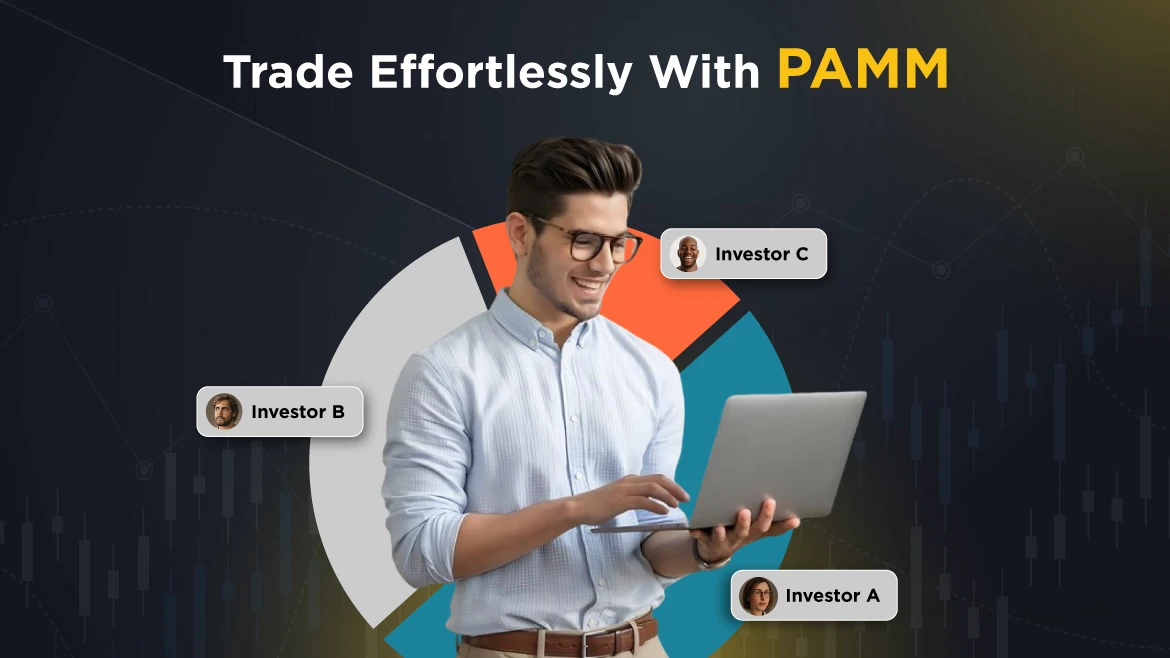What is PAMM Accounts in Forex and How does it work?

Want to take advantage of the forex market but don’t have the time or trading skills? A Forex PAMM account lets you invest with expert traders who do the hard work for you.
Key Highlights Of Forex PAMM Accounts
- Percentage Allocation Management Module (PAMM) is a system that allocates investor funds to a trader, who manages and trades the combined capital for shared profits.
- The investor (who provides the capital), the PAMM manager (who trades with the pooled funds), and the broker (who facilitates and oversees the system).
- The investor and the PAMM manager make profits — investors earn based on their share of returns, while the manager earns a performance fee from the profits generated.
What is PAMM?
PAMM stands for Percentage Allocation Management Module. It’s a smart investment system that allows you to put your money in the hands of experienced traders. Instead of trading yourself, you invest in a PAMM account managed by a professional who trades on your behalf. Any profits or losses are automatically shared based on the percentage of your investment.
It’s a simple way to access the forex market without needing to be an expert or watch the charts all day. Let’s examine the PAMM system using an example.
How the PAAM accounts work for the master and investor
The investors (let’s say Alex, Ben, and Sarah) want to earn money from forex trading, but they either don’t have the time to trade themselves or lack the knowledge to do it successfully. Enter the professional money managers — David, Emma, and Leo — who have strong expertise in forex trading and experience managing investor funds, much like mutual fund managers. They also invest their own trading capital alongside their clients’.
The forex trading firm signs up David, Emma, and Leo as money managers to handle investments on behalf of others. At the same time, the investors (Alex, Ben, and Sarah) also register and grant a Limited Power of Attorney (LPOA).
This agreement outlines that the investors fully accept the risks involved in forex trading and authorize the money managers to trade on their behalf. It also clearly defines how the managers will be compensated — either as a fixed fee, a percentage of profits, or both.
Let’s assume that all three investors choose David to manage their portion of the funds for forex trading, and David charges a 40% fee on any profits earned.
Each investor holds a specific percentage of the pool based on a total PAMM fund of $45,000. Remember, the combined share of all investors will always equal 100%.
Alex = $12,000 / $45,000 = 26.67%
Ben = $10,500 / $45,000 = 23.33%
Sarah = $7,500 / $45,000 = 16.67%
David (Manager) = $15,000 / $45,000 = 33.33%
Suppose one trading term passes (for example, a month), and David successfully earns a 30% profit on the pooled fund.
The total pool, originally $45,000, grows by 30%, which is $13,500 in profit.
So, the new account balance now stands at $58,500 ($45,000 + $13,500).
Profit Details (After One Trading Term)
Total Profit = 30% of $45,000 = $13,500
David’s Performance Fee = 40% of $13,500 = $5,400
Remaining Profit to Distribute = $13,500 – $5,400 = $8,100
Profit Distribution (Based on Contribution%)
| Participant | Share (%) | Profit Share ($8,100) |
|---|---|---|
| Alex (Investor) | 26.67% | $8,100 × 0.2667 = $2,160 |
| Ben (Investor) | 23.33% | $8,100 × 0.2333 = $1,890 |
| Sarah (Investor) | 16.67% | $8,100 × 0.1667 = $1,350 |
| David (Manager) | 33.33% | $8,100 × 0.3333 = $2,700 |
| Total | 100% | $8,100 |
New Trading Term: Updated Capital Contributions After Profit Distribution
After a strong 30% return in the first term, all three original investors chose to continue with David as their PAMM manager.
Continuing Investors:
Alex reinvests the full amount:
$12,000 (original) + $2,160 (profit) = $14,160Ben reinvests the full amount:
$10,500 (original) + $1,890 (profit) = $12,390Sarah withdraws her profit, keeping only the original investment:
$7,500 – $1,350 = $6,150
PAMM Account Manager:
David retains both his original investment and his share of the profits:
$15,000 + $2,700 = $17,700
New Investors:
Liam joins the pool with 3x $2,625 = $7,875
Nina signs up with 3x $1,000 = $3,000
Total Pool for the New Term
$14,160 (Alex) + $12,390 (Ben) + $6,150 (Sarah) + $17,700 (David) + $7,875 (Liam) + $3,000 (Nina) = $61,275
New Percentage Shares
| Participant | Amount ($) | Share (%) |
|---|---|---|
| Alex (Investor) | $14,160 | 23.11% |
| Ben (Investor) | $12,390 | 20.22% |
| Sarah (Investor) | $6,150 | 10.04% |
| David (Manager) | $17,700 | 28.89% |
| Liam (Investor) | $7,875 | 12.85% |
| Nina (Investor) | $3,000 | 4.90% |
| Total | $61,275 | 100% |
Second Trading Term: 15% Return Managed by David
After continuing with David for a new trading term, the PAMM account earns a 15% return on the total pool of $61,275. Based on this performance:
Total profit generated = 15% × $61,275 = $9,191.25
David’s performance fee (40%) = $3,676.50
Remaining profit for distribution = $9,191.25 – $3,676.50 = $5,514.75
Profit Distribution by Share%
| Participant | Share (%) | Profit Share ($5,514.75) |
|---|---|---|
| Alex (Investor) | 23.11% | $1,274.73 |
| Ben (Investor) | 20.22% | $1,114.74 |
| Sarah (Investor) | 10.04% | $553.55 |
| David (Manager) | 28.89% | $1,593.63 |
| Liam (Investor) | 12.85% | $708.14 |
| Nina (Investor) | 4.90% | $270.00 |
| Total | 100% | $5,514.75 |
Updated Account Balances
| Participant | Previous Balance | Profit Share | New Balance |
|---|---|---|---|
| Alex (Investor) | $14,160 | $1,274.73 | $15,434.73 |
| Ben (Investor) | $12,390 | $1,114.74 | $13,504.74 |
| Sarah (Investor) | $6,150 | $553.55 | $6,703.55 |
| David (Manager) | $17,700 | $1,593.63 | $19,293.63 |
| Liam (Investor) | $7,875 | $708.14 | $8,583.14 |
| Nina (Investor) | $3,000 | $270.00 | $3,270.00 |
| Total | $61,275 | $5,514.75 | $66,789.75 |
Third Trading Term: 20% Loss Under David's Management
Unfortunately, in this trading cycle, David incurs a 20% trading loss on the total pool of $66,789.75. Because it’s a loss, no performance fee is taken, and all investors’ account balances are reduced by 20%, including David’s own share.
Loss Calculation
Total Loss = 20% of $66,789.75 = $13,357.95
New Total Pool = $66,789.75 – $13,357.95 = $53,431.80
Updated Investor Balances After 20% Loss
| Participant | Previous Balance | -20% Loss | New Balance |
|---|---|---|---|
| Alex (Investor) | $15,434.73 | –$3,086.95 | $12,347.78 |
| Ben (Investor) | $13,504.74 | –$2,700.95 | $10,803.79 |
| Sarah (Investor) | $6,703.55 | –$1,340.71 | $5,362.84 |
| David (Manager) | $19,293.63 | –$3,858.73 | $15,434.90 |
| Liam (Investor) | $8,583.14 | –$1,716.63 | $6,866.51 |
| Nina (Investor) | $3,270.00 | –$654.00 | $2,616.00 |
| Total | $66,789.75 | –$13,357.95 | $53,431.80 |
End-of-Term Options
At the end of each trading term, investors have several choices:
Stay with the current money manager (David)
Partially or fully switch to another manager
Withdraw part or all of their investment
This flexibility allows investors to manage their risk and adapt to performance results over time.
In this example, David is the money manager, while Alex, Ben, Sarah, Liam, and Nina are the investors who entrust their funds to him through a PAMM account.
When David generates a profit from trading, he charges a 40% performance fee on the total profits. The remaining 60% of the profits are then distributed to the investors according to their share in the overall investment pool.
Understanding the Role of a Forex Broker in Trading
Provide a secure and reliable trading platform that connects money managers with investors.
Support trading activities by ensuring money managers operate within regulatory guidelines.
Handle essential account operations such as deposits, withdrawals, and overall account management.
Enable transparency and trust through reviews, ratings, and feedback systems, helping investors and money managers make informed decisions and interact confidently.
How Do Investors Choose a Money Manager?
Brokerage firms make it easy for investors to pick the right money manager by offering clear, helpful information. This includes the manager’s experience, qualifications, past performance, total funds managed, and the number of investors they work with. Investors can also read reviews and ratings to see what others have said. In addition, some brokers provide external ratings to help investors make confident, informed decisions.
Things to Keep in Mind About Investors
Investors do not choose the trading assets directly; they are limited to the instruments selected by the money manager (David in this case).
While investors benefit when David performs well, they also bear the risk of losses based on his trading decisions. Their capital is subject to market performance and the manager’s strategy.
Things to Keep in Mind About Money Managers
David can only trade with the funds allocated to him by each investor. He cannot access or trade beyond the specified amount. For instance, if Alex has $12,000 in his account but allocates only $4,000 to David, then David can only use that $4,000 for trading.
David may set limits by requiring a minimum or maximum investment amount from potential investors.
He also has the right to accept or reject investors based on his strategy, preferences, or risk tolerance.
What Does PAMM Stand For?
PAMM stands for Percentage Allocation Management Module (or Percentage Allocation Money Management). It’s a system used in forex trading where investors’ funds are pooled and managed by a professional trader, with profits and losses distributed proportionally based on each investor’s share.
What Is a Forex Broker’s Role in a PAMM Account?
A forex broker plays a crucial role in the PAMM system by:
Providing a secure and reliable platform where investors and money managers can connect and collaborate.
Enabling money managers to trade efficiently while ensuring all activity stays within regulatory guidelines.
Handling essential operations such as account management, deposits, withdrawals, and transaction tracking.
Offering transparent tools like reviews, ratings, and feedback systems to help investors and managers evaluate and interact with one another confidently.
What Is an Investor’s Role in a PAMM Account?
Investors typically don’t choose the trading assets themselves—they rely on the money manager’s strategy and decisions.
They accept the risk of potential losses, as their capital is exposed to the manager’s trading performance. However, they also benefit from any profits generated by successful trades.
The Bottom Line
PAMM accounts offer a straightforward way for individuals to invest in forex by allocating their funds to experienced money managers. This allows investors to potentially earn profits with minimal active involvement. However, like any investment, PAMM accounts carry risks, including the possibility of capital loss if the manager performs poorly.
Before investing, individuals should carefully assess their risk tolerance and return expectations and conduct thorough due diligence when choosing a PAMM broker and money manager to ensure their goals are aligned.

